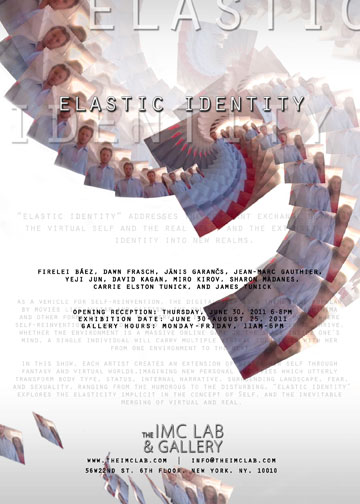
FOR IMMEDIATE RELEASE: Elastic Identity opening at The IMC Lab + Gallery on June 30, 2011 New York, New York - June 15, 2011 - The IMC Lab + Gallery is pleased to present Elastic Identity, which will be open from June 30 - August 25. This group show addresses the constant exchange between the virtual self and the real self, and the extension of identity into new realms. Working in media art, video, painting, and sculpture, the participating artists are Firelei Báez, Dawn Frasch, Jānis Garančs, Jean-Marc Gauthier, Yeji Jun, David Kagan, Miro Kirov, Sharon Madanes, Carrie Elston Tunick, and James Tunick. As a vehicle for self-reinvention, the digital self is a theme made popular by movies like Avatar and Catfish, the online game Second Life, Machinima and other forms of digital puppetry. We increasingly live in a world where self-reinvention occurs daily and is fast becoming vital in order to thrive. Whether the environment is a massive online game or the space inside one's mind, a single individual will carry multiple virtual identities with her from one environment to the next. In this show, each artist creates an extension of his or her self through fantasy and virtual worlds, imagining new personal realities which utterly transform body type, status, internal narrative, surrounding landscape, fear, and sexuality. Ranging from the humorous to the disturbing, "Elastic Identity" explores the elasticity implicit in the concept of Self, and the inevitable merging of virtual and real. This show is curated by Yeji Jun, Carrie Elston Tunick, and James Tunick.
Firelei Báez

Untitled, From the Carib's Jhator Series
Acrylic on Canvas, 16 x 20 inches, 2011

Untitled, From the Carib's Jhator Series
Acrylic on Canvas, 16 x 20 inches, 2011
Jhator, a gift of the body to the sky in Dominican lore, is an expressed desire for dematerialization. The self, freed after wandering and reminiscing for forty-nine days, transcends. Báez’s paintings link the freed body and the frenzied scream, emphasizing the inextricable bonds between psychic and physical self-assertion.
Carrie Elston Tunick

Michael
22min Single Channel Video, 2010
Michael is an amalgamation of images of Michael Jackson fans in various states of ecstasy. This piece addresses the ambiguous relationship between love, obsession, terror, celebration, and mourning. 
Diana
4min Double Channel Video, 2011
Diana is comprised of imagery of Princess Diana’s fans; the spectators at her funeral procession, and the spectators at her wedding procession. The juxtaposition of revelry and grief highlights the fluidity between seemingly opposite emotions, as well as the extremism of celebrity adoration.
Dawn Frasch

Healthcare blues (paint my body free)
Oil on Canvas, 58 x 46 inches
In her newest video, in the ancient brain of no memory, Frasch reinvents herself as a character Sagapriscilla (with four boobs) who is a mystical painter whose paintings come alive. Her name is a combination of two Latin names that mean "witch" and "of ancient time". She is haunted by the ghost of Peter Paul Rubens reincarnated as a Reuben sandwich. Frasch uses absurdist twists on classical allegories to expose the flaws of stories being manipulated to fit a moral objective. Through her work she explores the flaws of political/ethical systems without conveying a moral agenda.
Jean-Marc Gauthier

Crosswalks
Interactive Animation, Virtual World
1 or 3 flat screens display, 2011
Each work is specifically created for each client with four intersections of their choices.
Crosswalks is a virtual reality simulator that recreates the spatial experience of a pedestrian crossing a street intersection. The viewer stands in front of a 180-degree screen with projections of interactive 3D animations of pedestrians, street traffic and sound environments. The location and the parameters of the street intersection can be changed in real time. Data about urban design, architecture, traffic patterns and weather can be uploaded and the scenes can be saved. The multi-screen immersive environment is designed and produced by Jean-Marc Gauthier in collaboration with Fabien Barati at Emissive. The virtual world is used by Lei Liu and his team from University of Alabama in Birmingham for research on people with low vision inside an urban environment. The research is funded by a grant from the National Eye Institute. This innovative project helps them to evaluate why someone with low vision will decide to cross the street when immersed in a virtual world.
Yeji Jun

Thinking Blocks
Acrylic on Wood Block
3.5 x 3.5 inches each cube - 150 cubes, 2011
Thinking Blocks is an interactive sculpture that the viewer can paly with.
Jun’s work consists of “snapshots” of her subconscious state. Her work is a method of conversation with both herself and the viewer, a continuous process of exploring fantasy, romance, humor, self-doubt, narcissism, hope and the general mundaneness of life.
David Kagan

Hubris
From the 12 Deadly $teps Series
2009, Digital Print, 22 x 34 inches, 24 x 36 inches framed
The twelve images in The 12 Deadly $teps series serve as faux “film stills” from a sister video project, The Redacted Bunny. Each still relates thematically to a counterpoint episode, and borrows its form from a well-known painting or photograph.
Hubris is based on Michael Halsband’s iconic show advertisement for Andy Warhol and Jean-Michel Basquiat.

The Year In Review
Vinyl Records, 2010
In The Year In Review, Kagan is reformatting and repurposing his social interactions into a pop cultural structure that serves to distance himself from his own self-analysis. As the theory goes, he can then view this "other self" dispassionately and realize objective truths about himself. Kagan is engaging in a futile attempt to psychoanalyze his avatar.

The Whitney Biennial Song
Single Channel Video, 2010
One of eight short films made to accompany the album tracks from The Year In Review, this piece is a self-examination of specific goals and motivations as relating to Kagan’s art career. An email exchange with an assistant curator is set against an electronic beat for the purposes of objective removal and personal edification. The Whitney Biennial Song incorporates footage from a live performance, to emphasize the public/private dichotomy. This piece was filmed in his parents’ attic.

Eye Blue Paul McCarthy
Single Channel Video, 2010
One of eight short films made to accompany the album tracks from The Year In Review, Eye Blue Paul McCarthy is an exercise in killing one's former idol. Its visuals are inspired by Scanimate, an analog computer animation system used from the late 1960s through early 1980s, is specifically referencing the 7UP “Bubbles” commercial campaign of 1974.
Miro Kirov

Self Portrait
Video – HD, 1024 x 720 pixels, 2011
The video Self Portrait is a whimsical capture of a moment in the artist’s life. Time is measured in rhythmic intervals, but it seems that time is not rigid; it is constantly variable and elastic. Kirov’s piece is contemplation on the meaning of physical existence, capturing a moment when mind alters form, appearance, and perception.

Self Portrait I
Digital Print, 10 x 12 inches, 16.5 x 20.5 inches framed, 2011

Self Portrait II
Digital Print, 10 x 12 inches, 16.5 x 20.5 inches framed, 2011
Sharon Madanes

Off-Season Terrorist
Oil on Panel, 24 x 18 inches, 2009
Off-Season Terrorist is an investigation by Madanes of sleeper cells.
James Tunick

Elastic Me
Interactive Software, 2011
James Tunick and Jānis Garančs

Parallel Cityscapes (PC)
Multimedia installation
2007
Parallel Cityscapes (PC) is an interactive audiovisual environment that imagines the future of the personal computer while revealing the "hidden" spaces and relationships between memories. PC depicts the parallels between modern cities and future memory spaces, representing an archive of hundreds of user-generated photographs, video sequences, drawings and computer graphics from the Web, from mobile devices, and from public spaces. This mind-bending journey is a visual paradox between real and virtual, imagining a future in which 3D browsers and media spaces merge with real cities and encourage more advanced forms of collaboration.

